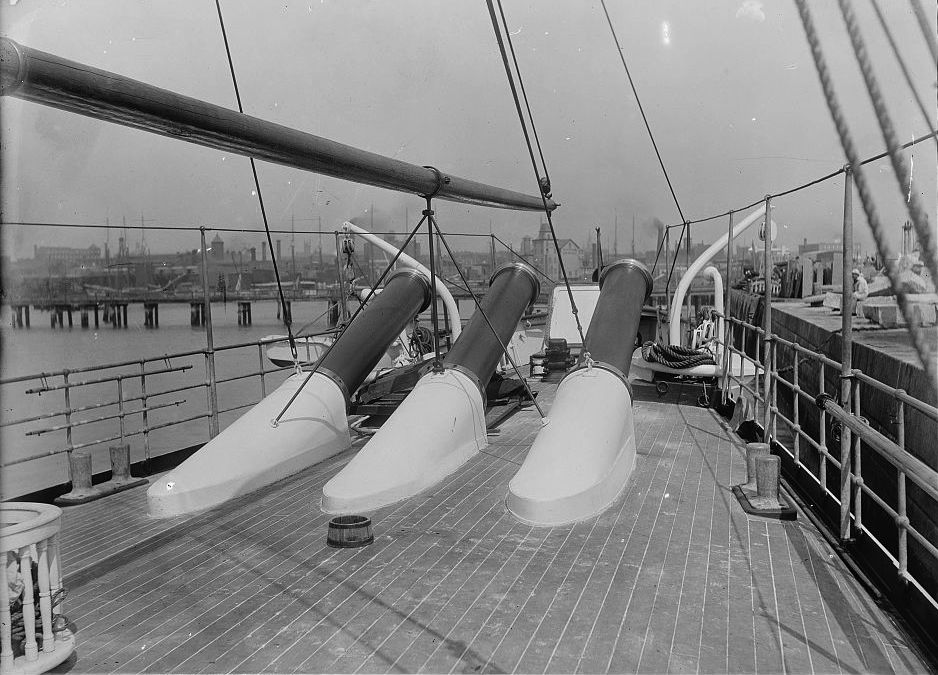We'll start alphabetically (A very good place to start) and on the left with the vessel farthest from us in the picture, USS Alarm.
Alarm was an experimental torpedo boat but, having been launched in 1873, was seriously old-school and thus, obsolete right out of the gate..
The later torpedo boats, the ones that destroyers were originally designed to... destroy, were the ones that usually had a forward compartment looking something like this:
Something like a narrow space with a torpedo... and a tube. We know it's supposed to have those things 'cause that's what a torpedo is so a torpedo boat would obviously be one that launched torpedoes.
Not Alarm, she used a hopelessly-antiquated design - but one that had been conceived less than a decade earlier. Technology moved fast back then.
That would be: the spar torpedo.
I know, the concept looks like it's just an explosive charge stuck onto the pointy end of a boat. Well, that's because... that's what it is/was.
If the idea of just t-boning your opponent seeming like a good idea is strange to you remember: CSS Virginia used the tactic to good effect at Hampton Roads in '62.
So, all that having been taken into consideration, why not just put a bomb on a stick - or three, to be used consecutively as in the case of Alarm? You're spared the hassle of providing propulsion to the torpedo. You just drive it on into the target.
It's a boss idea or it was until the Whitehead torpedo, perfected in 1866 and eventually adopted by... everyone came along. The perfect fire-and-forget weapon. No more demo-derby on the high seas. Alas.
Alarm, for all her brilliance, was really not much more than a flash in the pan.
But what a flash.
And she's not just cutting-edge at the bow. Check out what she's got out back.
That would be the Fowler-Wheel propeller.
Vertically mounted with the ability to be swung in either direction, it gave Alarm the maneuverability to essentially act like a giant mosquito to all those hapless, other-boats out there.
But slowly. She could shunt her ass around way quick but that's of limited importance when any boat with torpedo capability can wallow like a tug as long as it can get a clear shot and be within a quarter-mile. The Whitehead torpedo would do the rest. The Fowler prop made her maneuverable but slower than Christmas in a straight line.
Alarm finished up being shot at for a living until she was sold for scrap. Sad.
Moving right along; we'll ignore the sailing vessel in the foreground. I think it's a prop in any case.
Next up is: USS Vesuvius.
Is that a great name or what? Better yet the Nav classified her as a "dynamite gun cruiser" (Dibs on that as the name for my nascent, Nordic-death-metal-pop band. we're gonna be big!).
She resembled Alarm in that she too had to be "aimed" at her target.
In the pic you can see her three pneumatic, "dynamite guns" just ahead of the forward mast.
We'll get the boat's other armament out of the way first. It had three, three-pounder guns - and the three big boys.
Fifty-five feet long with an inside diameter of fifteen inches each dynamite gun was a fixed-in-place, cast-iron tube that extended below decks.
Of course, the guns weren't fired by dynamite, they used compressed air at 1000 psi and, truth be told, the explosive charge in the projo wasn't actually dynamite either. It was close - and far closer to it than anything else. Therefore, with the right propulsion, this sensitive, artistic "desensitized blasting gelatin" could be gently shoved out the tube without upsetting it enough to... you know - blow it up.The payload they sent away comprised the following (From the mind of Wiki):
"The shells fired from the guns were steel or brass casings 7 feet (2 meters) long with the explosive contained in the conical forward part of the casing and spiral vanes on the after part to rotate the projectile."
550 pounds of the aforementioned, desensitized gelatin could be conveyed about one mile. 220 could go about two-and-a-half. Range corrections were made by adjusting air pressure.
She worked a treat and during the Spanish American War, she spooked the Spanish by bombarding Santiago by stealth.
The psychological effect of this silent killer put the jitters into the Spaniards, something about a quarter-ton of nitroglycerin-based explosive arriving unannounced minus the comforting get-your-heads-down gun report that the familiar, old-school, naval bombardments would provide as a matter of course. Sneaky.
Thing was, through time, counseling and some sympathetic friends, nitroglycerin became less sensitive and better able to cooperate with her coworkers in the propellant department. After that the dynamite gun was pointless. Hell, less than twenty years later all of Europe was air-mailing all sorts of nitro-based Easter eggs to one another without a second thought.
USS Vesuvius, thanks for coming in but we've got this now.







No comments:
Post a Comment